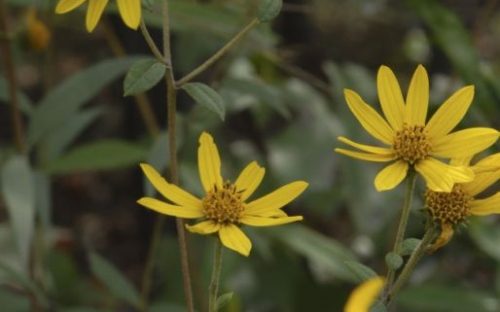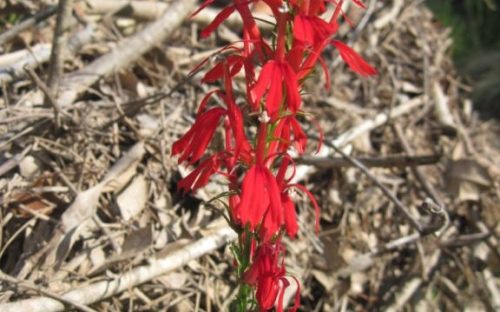Fall wildflowers

This last week in September finally saw a break in the heat from our hotter than average summer this year. Bringing us out of near-drought conditions, rain finally came and with it the 60s and 70s temps we’d all been waiting for so longingly. Unfortunately for some areas this sudden rush of rainfall also resulted in flash flooding. In the Uwharries, many rivers that had been almost bone dry from the hot summer were furiously full now, bursting over their banks almost overnight with last week’s rains.
Though the lack of rain up until now has left some trees and plants withering, our landscape of leaves has largely not quite yet begun to turn into the lovely orange, red and yellow hues characteristic of autumn. But we have another color cue from nature that fall is upon us – the suite of beautiful fall wildflowers that are already in bloom. Fall in North Carolina in terms of wildflowers largely means yellows and purples – in the form of sunflowers, goldenrod, and asters.
I spent this past weekend on a 51 mile trek on the Appalachian Trail, and similar colors were to be found all along the trail there as well. However, several of the plants found in the Uwharries are not only beautiful but really unique to this area as well. Piedmont prairies and savannas, with open sunlit groundcover, were once widespread in this area.  However, changes in silvicultural practices have greatly decreased this once abundant ecosystem, and the species found there as well. One suite of species found in these natural communities are piedmont prairie associated plants, now largely found along roadsides and in utility right-of-ways where they still retain enough sunlight to survive. Among these are the federally endangered Schweinitz’s sunflower and the state rare Georgia aster. Schweinitz’s sunflowers are a most showy species, growing to heights above 8 feet tall. Georgia asters, while not as prominent, are still a beauty to behold – lovely lavender with a white center.
However, changes in silvicultural practices have greatly decreased this once abundant ecosystem, and the species found there as well. One suite of species found in these natural communities are piedmont prairie associated plants, now largely found along roadsides and in utility right-of-ways where they still retain enough sunlight to survive. Among these are the federally endangered Schweinitz’s sunflower and the state rare Georgia aster. Schweinitz’s sunflowers are a most showy species, growing to heights above 8 feet tall. Georgia asters, while not as prominent, are still a beauty to behold – lovely lavender with a white center.
Other purples you will find this time of year include lobelia and clasping aster, while other yellows include smooth sunflower and numerous species of goldenrod and black-eyed susans or coneflowers. One additional plant that pops this time of year in contrast to these is the bright red cardinal flower, relatively common, and found largely in riparian areas.
The LandTrust will be hosting a wildflower and heritage hike during the Uwharrie Mountain Festival next weekend, October 9th. The festival is a celebration of the Uwharries and all things outdoor recreation oriented, and is in its fifth year now. There is truly something for everyone here, including a canoe race, a trail run, orienteering, gold panning, pottery demonstrations, great music and food and more. If you’d like to join us on our wildflower hike to see what other great floral finds we can discover, meet at the Eldorado Outpost at 1pm. Hope to see you there!
To see more beautiful flowers
–Photos by Bob Bailey & Crystal Cockman